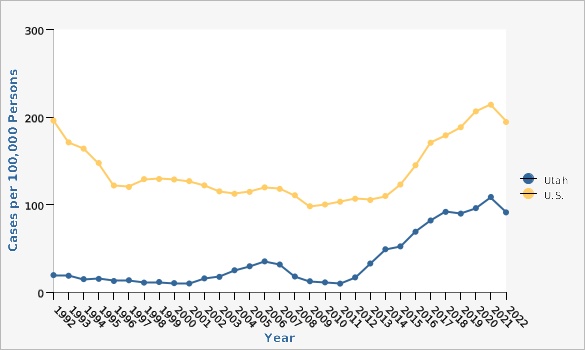Why Is This Important?
Although much less common than chlamydia infections, gonorrhea, caused by the bacterium ''Neisseria gonorrhoeae'', is a priority public health concern in Utah. Untreated gonorrhea infections can damage the reproductive systems of both males and females. Females with gonorrhea infection are at risk for developing pelvic inflammatory disease (PID), and both men and women may become infertile as a result of untreated gonorrhea infections. Also, susceptibility to infections such as HIV also increases when an individual has gonorrhea. Furthermore, pregnant women with gonorrhea can pass the infection to their infant during delivery, potentially resulting in ophthalmia neonatorum. Gonorrhea can spread to the blood stream and settle in the joints, brain, and heart becoming systemic or known as disseminated gonorrhea. In addition to the cervix and urethra, the rectum and pharynx are also possible sites of gonococcal infection.Gonorrhea, Utah and U.S., 1992-2022 |
Data Sources
- Utah Department of Health and Human Services Office of Communicable Diseases
- Population Estimates for 1999 and earlier: Utah Governor's Office of Planning and Budget
- For years 2020 and later, the population estimates are provided by the Kem C. Gardner Policy Institute, Utah state and county annual population estimates are by single year of age and sex, IBIS Version 2022
- Population Estimates for 2000-2019: National Center for Health Statistics (NCHS) through a collaborative agreement with the U.S. Census Bureau, IBIS Version 2020
- National Center for HIV, STD, and TB Prevention, Centers for Disease Control and Prevention
Data Notes
Rates were calculated by dividing the number of cases for each year by the total population within that year and multiplying by 100,000. Prior to 2009, Utah rates were calculated using the morbidity report date; effective 2009, rates were calculated using the date of diagnosis.Risk Factors
Risk factors for sexually transmitted diseases include:
* sexual activity among young adults 25 and younger
* multiple sex partners
* prior history of STIs
* unprotected sex
* illicit drug use.
[[br]]
Those who fall within one or more of these categories should be tested for STIs in regular intervals. Sites of infection may include pharynx, rectum, vagina, cervix, and urethra.How Are We Doing?
Following a doubling of the Utah gonorrhea rate from 2003 to 2006, when the rate peaked at 35.2 cases per 100,000 persons, the Utah gonorrhea rate decreased annually to the lowest reported rate of 9.8 in 2011. From 2011 to 2022, gonorrhea rates increased 830.6% to 91.2 cases per 100,000 persons.
In 2022, gonorrhea rates in the state were higher in males (118.4 cases per 100,000 persons) than in females (63.1 cases per 100,000 persons). Rates in females increased 1,242.6% from 2011 to 2022, compared to 694.6% among males during the same time frame.
The highest rates of gonorrhea in Utah in 2022 were among males aged 25 to 29 (370.1 cases per 100,000 persons) and males aged 30 to 34 (309.1 cases per 100,000 persons).What Is Being Done?
Persons who test positive for gonorrhea are confidentially interviewed by a disease intervention specialist (DIS) from a local health department (LHD) to educate the patient, ensure proper treatment, and to obtain sexual partner information for follow up. This process potentially prevents the spread of infection and reduces the likelihood of the patient becoming reinfected. The Centers for Disease Control and Prevention currently recommends that patients with gonococcal infections be treated with a mono antibiotic therapy to improve gonorrhea treatment effectiveness, and potentially slow the emergence of antibiotic resistance.
The Utah Department of Health and Human Services HIV/STD, Elimination, Analysis, Response, and Treatment (HEART) along with LHDs, currently provide STI presentations upon request to a variety of organizations, agencies, and facilities.
Date Indicator Content Last Updated: 02/23/2024

